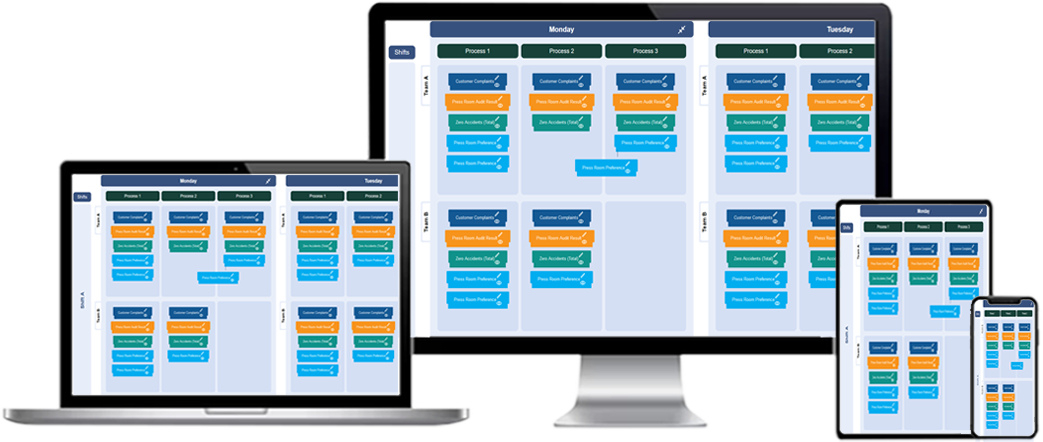T-Card software has become an essential tool for modern manufacturing businesses, offering a structured and visual approach to managing tasks, production schedules, and workflow processes. By replacing traditional manual T-Card boards with digital systems, manufacturers can streamline operations, reduce downtime, and enhance overall productivity.

1. Why Manufacturing Businesses Need TCard Software
Manufacturing environments require efficient coordination between departments, teams, and machines. T-Card software provides a centralized platform for tracking tasks, managing work orders, and ensuring seamless communication. Key benefits include:
- Real-time workflow visibility: Managers and operators can monitor task progress instantly.
- Improved task tracking: Automated logs ensure that no task is overlooked.
- Increased efficiency: Reduced manual paperwork and improved scheduling.
- Better resource allocation: Helps in balancing workloads and managing priorities.
- Enhanced reporting: Provides data-driven insights for continuous improvement.
2. Key Features of the Best Manufacturing TCard Software
When choosing T-Card software, manufacturers should look for features that align with their operational needs. The best software solutions offer:
- Customizable T-Card Templates: Adaptable formats for different workflows, such as production planning, maintenance tracking, and quality control.
- Drag-and-Drop Functionality: Simplifies task movement across workflow stages.
- Automated Alerts and Notifications: Ensures that deadlines and critical updates are not missed.
- Integration with ERP and MES Systems: Allows seamless data exchange for enhanced manufacturing efficiency.
- Cloud Accessibility: Enables remote access to task boards from any location.
- Analytics and Reporting: Provides insights into production trends, bottlenecks, and performance improvements.
3. How to Implement TCard Software in Manufacturing
Implementing T-Card software effectively requires a structured approach. Here’s a step-by-step guide to ensure successful adoption:
Step 1: Identify Operational Needs
Evaluate current workflow challenges and determine how T-Card software can improve efficiency. Common applications include job scheduling, maintenance tracking, and inventory management.
Step 2: Configure the Software
Customize the T-Card board to reflect manufacturing processes, defining categories such as pending tasks, in-progress work, and completed operations.
Step 3: Train Employees
Provide hands-on training to ensure users understand how to create, update, and manage T-Cards. Encourage teams to regularly update task statuses for accurate tracking.
Step 4: Integrate with Existing Systems
Connect the software with ERP, MES, and inventory management systems for streamlined operations and real-time data synchronization.
Step 5: Monitor and Optimize Usage
Regularly review performance metrics, identify workflow inefficiencies, and adjust configurations to enhance productivity.
4. Overcoming Common Challenges in T-Card Software Adoption
Despite its advantages, implementing T-Card software may present challenges, such as:
- Resistance to Change: Employees may initially prefer manual tracking methods.
- Data Accuracy: Ensuring users update tasks consistently to maintain workflow accuracy.
- Integration Complexity: Aligning the software with existing manufacturing systems may require technical support.
Addressing these challenges through proper training, phased implementation, and continuous monitoring will help in achieving a smooth transition.
5. The Future of TCard Software in Manufacturing
As technology advances, T-Card software will continue to evolve with features such as:
- AI-Powered Task Scheduling: Predictive analytics for workload distribution and demand forecasting.
- IoT-Enabled Automation: Real-time task updates based on machine performance data.
- Enhanced Mobile Accessibility: Seamless task management from smartphones and tablets.
By leveraging these innovations, manufacturers can optimize efficiency, reduce operational costs, and improve overall productivity.
Best manufacturing tcard software
What is manufacturing TCard software?
Manufacturing TCard software is a digital tool that helps track, manage, and optimize production workflows using a visual card-based system.
How does TCard software improve manufacturing efficiency?
It provides real-time task tracking, reduces manual errors, streamlines processes, and enhances overall workflow visibility.
What are the key features of TCard software for manufacturing?
Key features include task assignment, real-time updates, reporting, workflow automation, and integration with ERP and MES systems.
Can TCard software help with production planning?
Yes, it enables efficient task scheduling, resource allocation, and real-time monitoring of production progress.
How does TCard software enhance task tracking?
It provides a centralized visual board that displays task status, responsible teams, deadlines, and progress updates.
Is TCard software suitable for small and large manufacturers?
Yes, it is scalable and can be customized to fit the needs of both small workshops and large-scale manufacturing plants.
How does TCard software support real-time monitoring?
It allows users to track tasks, identify bottlenecks, and adjust priorities instantly for improved production efficiency.
Can TCard software integrate with other manufacturing systems?
Yes, it can integrate with ERP, MES, and other production management tools to enhance data synchronization.
How does TCard software help reduce downtime?
By identifying workflow inefficiencies, tracking machine maintenance, and ensuring timely task execution, it minimizes production downtime.
Does TCard software support lean manufacturing principles?
Yes, it helps eliminate waste, improve task flow, and enhance productivity by following lean manufacturing methodologies.
Can TCard software improve workflow automation?
Yes, it automates repetitive tasks, assigns responsibilities, and ensures smooth task transitions to improve efficiency.
Does TCard software support cloud-based access?
Many solutions offer cloud-based access, enabling remote task management and real-time updates across multiple locations.
How does TCard software assist in compliance tracking?
It helps monitor quality control, record production data, and generate reports to ensure regulatory compliance.
What security features should TCard software have?
Security features should include role-based access, encryption, audit logs, and data backup to protect sensitive manufacturing data.
How can manufacturers implement TCard software effectively?
Effective implementation involves staff training, integration with existing systems, customizing workflows, and continuous performance monitoring.